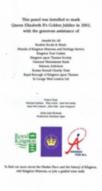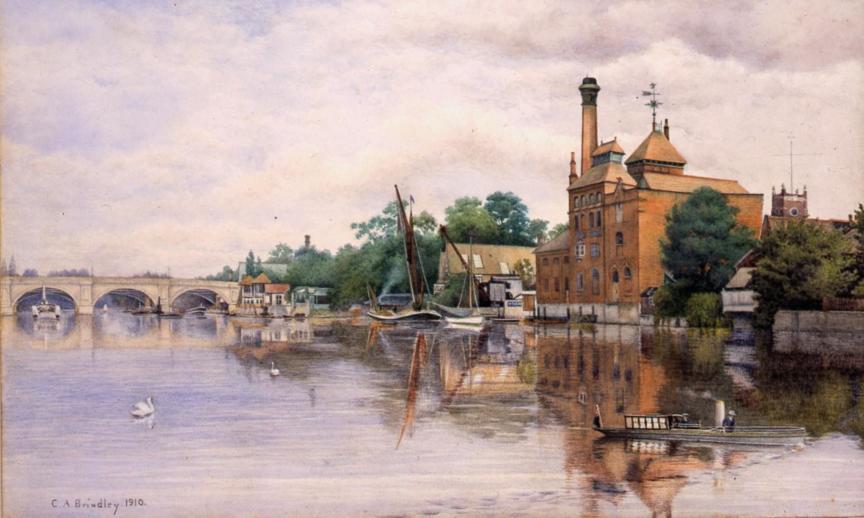
Fricker’s Eagle Brewery by C A Brindley, 1910
(Kingston Museum & Heritage Service)
THE GROUP OF FOUR
The history of an informal working party
dedicated to the enhancement of
Kingston Town
April 2017
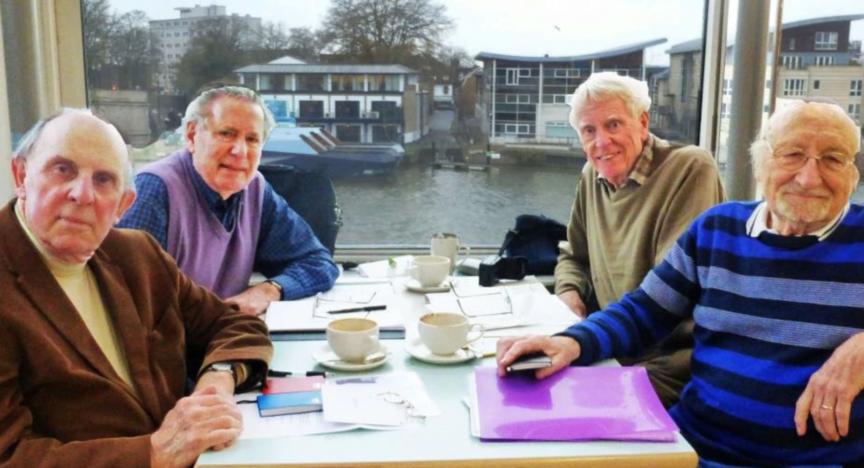
About
In 1999 John Pink, a Kingston Tour Guide, produced a study of coaching in Kingston. This aroused the interest of Tony Leitch and Michael Davison, both members of the Kingston upon Thames Society, and John McCarthy of the Friends of Kingston Museum & Heritage Service. They agreed to meet John Pink to discuss the possibility of putting up an information panel in the Market Place telling the story of the history of the Ancient Market Place as they felt not many of the public are aware of this, in particular how important the stagecoach days were to our town. Thus was born what became the Group of Four (G4) – an informal group dedicated to positive and practical initiatives to enhance the townscape of the Royal Borough. After Tony Leitch, G4’s Architect member, died in 2008 Brian Godding, also an Architect and member of the Kingston upon Thames Society, agreed to join the Group.
Contact
Michael Davison
Brian Godding
John McCarthy
John Pink
Projects
- ANCIENT MARKET PLACE INFORMATION PANEL
- THE STAGECOACH and THE EMBROIDERY, MARKET HOUSE
- OLD KINGSTON BRIDGE AND UNDERCROFT
- EAGLE BREWERY WHARF
- QUEEN ANNE STATUE
- NAME PLATES FOR ANCIENT MARKET PLACE PASSAGES
- JAMES SQUIRE & JAMES BLOODSWORTH
- THE OLD KINGSTON TELEPHONE EXCHANGE
- COOMBE CONDUIT RIVER CROSSING
- BUS SHELTER OUTSIDE THE GUILDHALL
ANCIENT MARKET PLACE INFORMATION PANEL
It was planned to install the three-part panel in the Shrubsole Passage in time for the Queen’s Golden Jubilee in 2002. It took rather longer but finally a grand unveiling ceremony by the Mayor, Councillor Dennis Doe, took place in November 2003. The left-hand panel puts the Market Place into its historical context. The central panel has colour pictures researched in conjunction with the Museum’s Local History Room, and historical anecdotes, to explain the history of Kingston’s Ancient Market Place. The right-hand panel acknowledges the debt to local people and organizations for their support on the project. John Richards, a graphic artist with a feeling for history and costume and a limitless store of patience and who had done previous work for Kingston Museum, created images from the researched material and then transferred them onto steel panels, fired in a kiln to make them hard-wearing, and added the finishing colours by hand. In addition, the Council was persuaded to install next to the Panel the nameplate Shrubsole Passage.
The Group had succeeded in getting funding for the panel from Kingston Council, local businesses and the National Lottery. However, it became increasingly difficult to fund such ambitious projects so, despite the success with the panel, the Group decided in future to concentrate on smaller, less costly projects, though still with the same aim of enhancing the town centre. The first of these was designed to give even greater prominence to the stagecoach theme by installing a print in the Market House.
THE STAGECOACH and THE EMBROIDERY, MARKET HOUSE
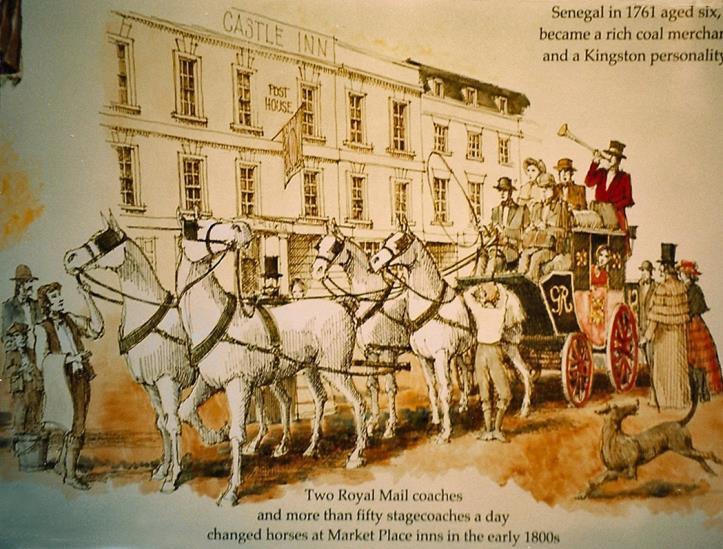
This large copy of the picture, which is the central feature of the Shrubsole Passage Information Panel, was produced by the Group for display in 2004 in what was then the Information Centre in the Market House. Other pictures from the panel were transferred to a video which was displayed in the Market House on a permanent loop. Unfortunately with the closure of the Centre both the picture and the embroidery were removed and are now in storage.
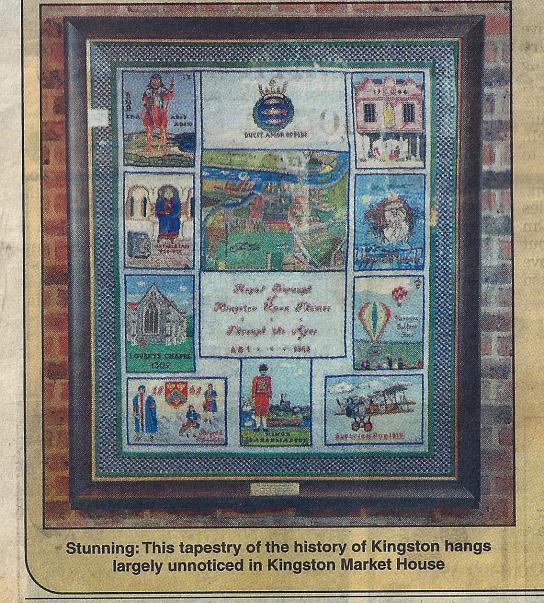
Also installed in the Market House in 2007, just underneath the Stagecoach picture, was an Embroidery showing Kingston scenes made by the Kingston Embroiders Guild to celebrate the Millennium. It had been lying neglected in a corner of the North Kingston Centre until the Group of 4 rescued it and gave it a place of honour in the Market House.
OLD KINGSTON BRIDGE AND UNDERCROFT
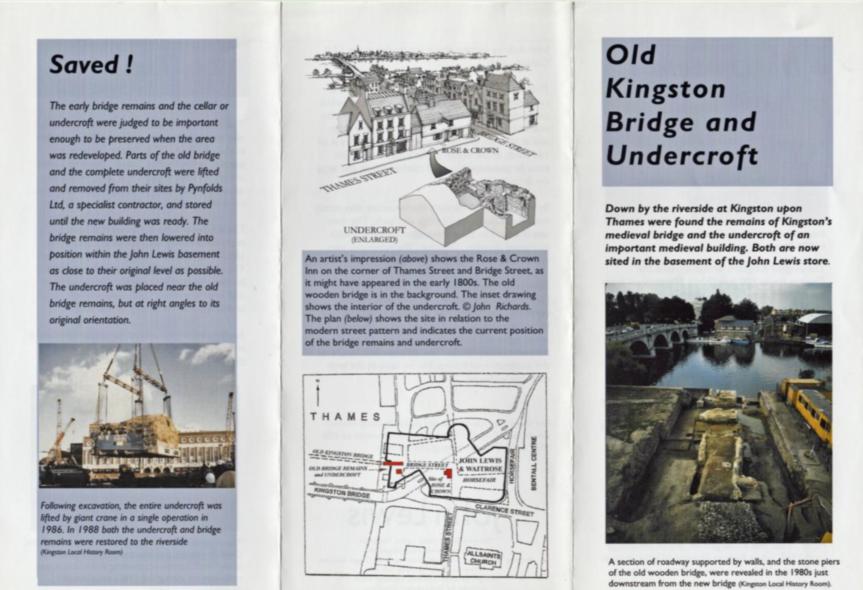
In 2006 the Group of Four noted the lack of information in the window of the cellar under John Lewis containing the historic Old Kingston Bridge remains and Undercroft. They approached John Lewis who not only agreed to display panels in the windows to the design of the Group but also to sponsor a coloured leaflet, see below, which with the assistance of Anne McCormack, Kingston’s Heritage Officer, was produced and printed in 2009. John Richards, the graphic artist of the Shrubsole Passage panel, drew sectional drawings showing how the Undercroft was originally situated and a ‘realisation’ of how Thames Street, Bridge Street and the old wooden Kingston Bridge looked in the early 1800s. Copies of the leaflet are given free to all visitors when the Undercroft is opened to the public, and John Richards’s work is displayed on the notice board inside.
EAGLE BREWERY WHARF

The Group of Four was invited In 2004 to join a Steering Group set up by the Council to investigate proposals to redevelop the former Eagle Brewery site as a public open space. Tony Leitch designed an amphitheatre scheme and although this was not pursued it did provide a basis from which the final design was developed. The project was completed in 2010 and incorporates a bronze plaque designed by the Group. The plaque incorporates an illustration of the brewery (see also frontespiece) with a text, below right, and is installed on top of the river wall.
“On this site Thomas Fricker founded his Eagle Brewery early in the 19th century. He passed it on to his son Arthur whose death aged 37 resulted in the business being run by trustees until the Brewery and its 38 tied public houses were sold at auction in 1903 to Hodgson’s Kingston Brewery. The striking new brewery built by Fricker’s in the 1870s ceased brewing before 1914, after which it was used by Hodgson’s for storage. By the late 1920s the wharf was in use for unloading coal with two large cranes, one on the wharf and the other on top of the downstream end of the building. In 1971 the site was bought by Kingston Council for its proposed Relief Road but when this scheme was dropped it was cleared and temporary Council offices erected. It was later laid out as an open space. In 2010 Eagle Brewery Wharf was renovated by Kingston Council with the aid of a Transport for London grant. The improvements have created a notable scheme worthy of a Thames-side Town Centre recreational area.”
QUEEN ANNE STATUE
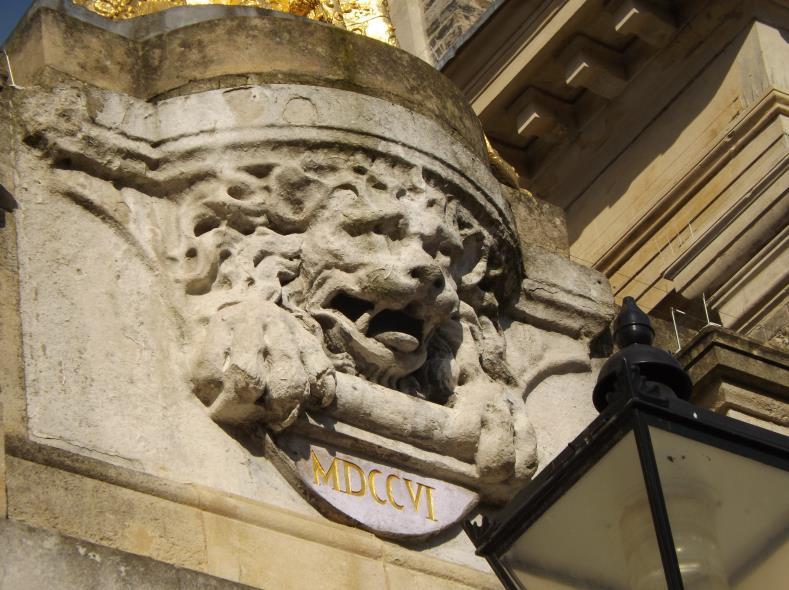
In 2006 the statue of Queen Anne on the Market House was about to celebrate the 300th anniversary of its installation in 1706. The good lady herself had recently been regilded, but a panel beneath the statue bearing the date in roman numerals MDCCVI had over the years become so eroded as to be virtually illegible. After much pressure the Council was persuaded to pay for the work and in September the Mayor, Councillor Mary Reid, unveiled the regilded date with an unusual loyal toast ‘To Her Majesty Queen Anne’.
NAME PLATES FOR ANCIENT MARKET PLACE PASSAGES
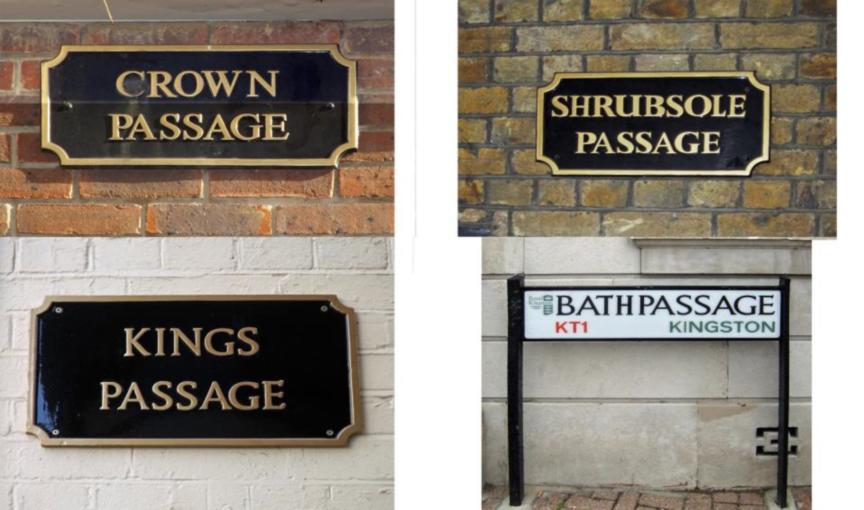
Following the naming of Shrubsole Passage the installation of name plates in three other passageways off the Market Place was a further successful Group project, with John Pink taking the initiative. After prompting, signs were placed by RBK in Crown Passage in 2005, Bath Passage in 2013 and Kings Passage (Market Place side) in 2015.
Kings or King’s? At Kings Passage the new name plate followed an existing Council finger post on the riverside in having no apostrophe. Also there is a popular belief that more than one medieval monarch may have used the Passage as a route between the Thames and the Market Place. However, local historian June Sampson attributes the name to John King, who in the 19th century had a drapery shop on the Passage’s Thames Street corner. The signs showing Bath Passage are less ambiguous! The Passage Way runs along the north side of the now demolished mid-Victorian bathhouse
JAMES SQUIRE & JAMES BLOODSWORTH
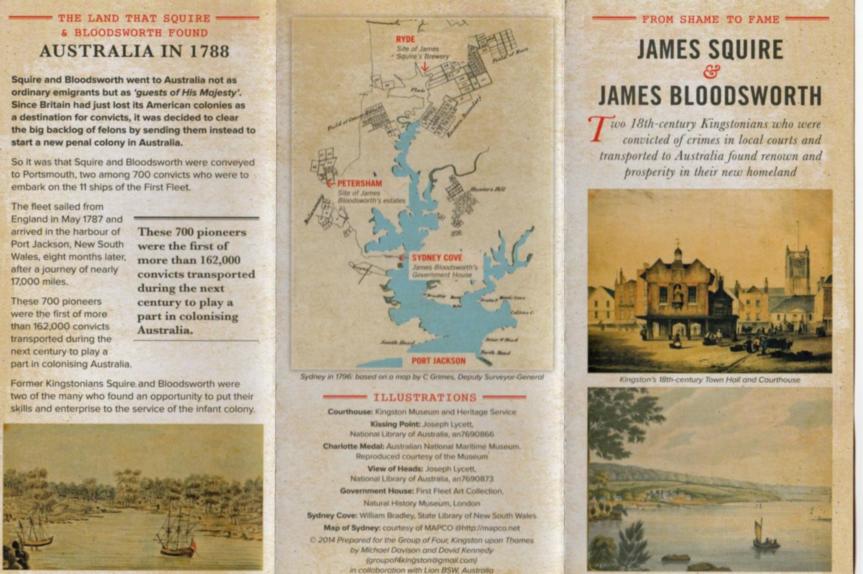
After the success of the Undercroft leaflet, the Group was inspired by a talk given by Dr David Kennedy to the Kingston upon Thames Society about his research on two 18th-century Kingston felons who were convicted of theft and transported to Australia on the First Fleet that established the infant New South Wales colony. Here, remarkably, they became model citizens in different spheres: James Bloodsworth designed many of Sydney’s first buildings, including the first Government House; James Squire established Australia’s first commercial brewery. At the end of his talk Dr Kennedy threw down a challenge: ‘You’re the Kingston Society, why don’t you put up a plaque to these Kingstonians who made good in the New World?”
Realising a plaque might be difficult to achieve, the Group took up the challenge in a more immediately practical way, by preparing a leaflet. With help from Australian museums and university sources a draft was put together: but how to pay for it? It was then discovered that James Squire Brewery was still in being, owned now by a conglomerate but producing beers named to refer to James Squire’s colourful life. When an approach was made to them for a financial contribution, to the Group’s surprise they responded saying: ‘Send us text and pictures and we’ll produce the leaflet and supply you with copies’. So you can now see the result, available for sale in Kingston Museum, Kingston History Centre and most libraries.
THE OLD KINGSTON TELEPHONE EXCHANGE
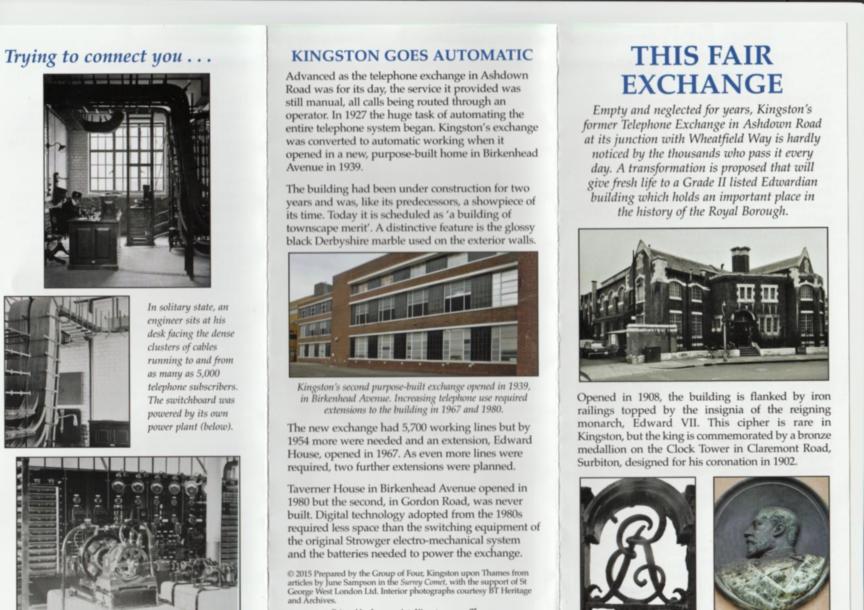
The Grade II Listed building in Ashdown Road, opened in June 1908, was Kingston’s first purpose-built telephone exchange, designed by John Rutherford of the Ministry of Works in the ‘Arts and Crafts` style. With St George’s preparing a planning application to redevelop the site, the Group asked in 2015 if they would sponsor a leaflet similar to the John Lewis Undercroft & Old Bridge Footings leaflet, to which they readily agreed; they also sponsored a painting for the Brill Collection. The leaflet took as its starting point a series of articles by June Sampson in the Surrey Comet in 2001 under the title ‘Ringing the Changes’ and a subsequent article in 2007 ‘Home for the Fair Exchange’, from which the Group leaflet derived its name. As with our other leaflets copies are available at the Museum, Kingston History Centre and some libraries.
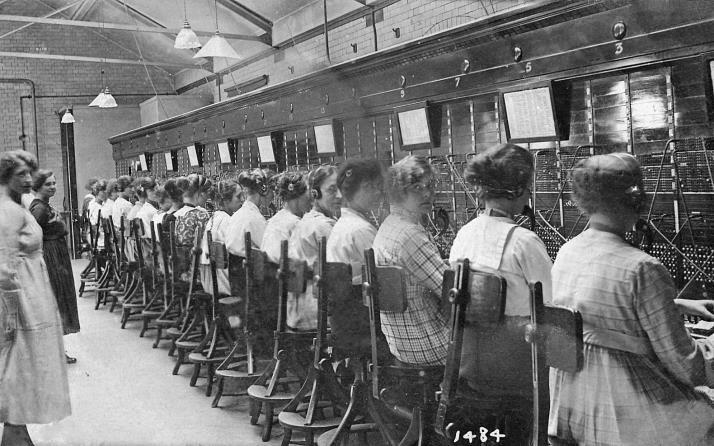
Following its publication an appeal was made in the local press resulting in the discovery of this probably unique picture of a switchboard in the Kingston Exchange in the early 1920s.
COOMBE CONDUIT RIVER CROSSING
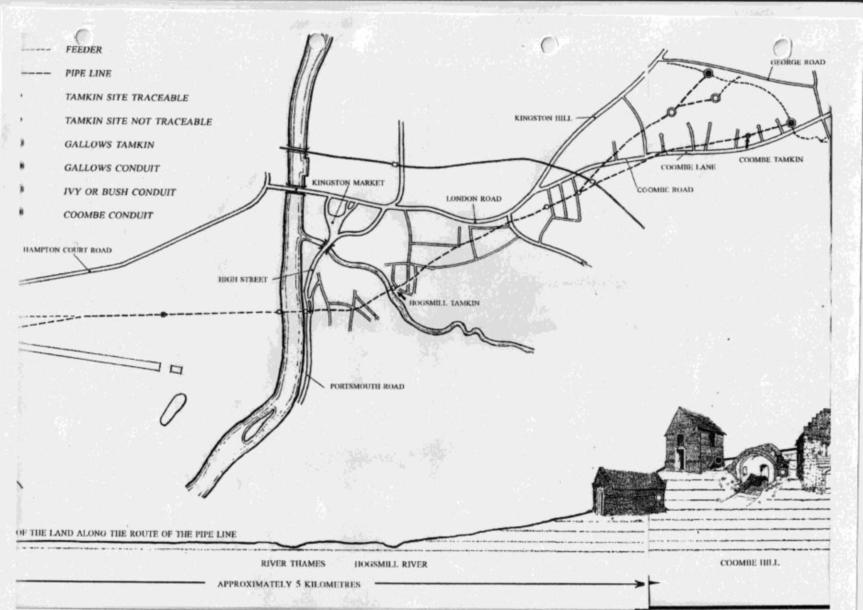
Since 2008 the idea has been considered of installing an information panel on Queen’s Promenade and another on the opposite bank to indicate where a 16th-century conduit, bringing water from Kingston Hill to Hampton Court Palace, crossed the Thames. The basis of the panel would be an earlier plan (see above) which plots the position of the three Conduit Houses where spring water was collected in large cisterns, then channelled through lead pipes downhill under what is now the centre of Kingston.
The panel proposal and other alternatives were considered but held in abeyance pending raising funds. In 2016 with the Go Cycle project in Portsmouth Road under construction it was felt this might be an opportune time in the hope it could form part of the Public Realm elements of the scheme. However this was not possible so the Group decided to pursue, in conjunction with the Council, the scheme in its own right, having established on the riverside the approximate position at which the Conduit crossed the Thames.
BUS SHELTER OUTSIDE THE GUILDHALL
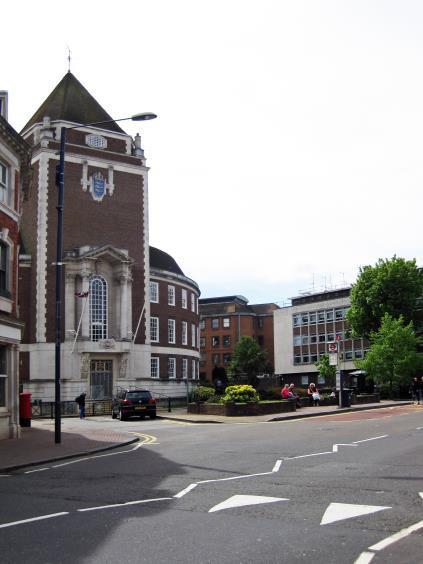
The bus stop outside the Guildhall for routes out of the town centre is one of the few, if not the only, major bus stop without a shelter. Waiting passengers have nothing to protect them from the often wet & windy conditions experienced in this open location, some of whom can be there for a considerable length of time. In April 2015 a letter was published in the Surrey Comet appealing for one to be provided and Transport for London was approached but despite strenuous efforts they took no action. Eventually in 2016 the Group felt they had done all they could, and passed the proposal on to Council Members to pursue.
PROGRESS

A sculpture called Progress (also known as Aspiration) by Kathleen Scott (1878-1947) used to stand between the escalators in the atrium of the 1930s rebuild of Bentalls. Kathleen Scott was the wife of Antarctic explorer Robert Falcon Scott and the mother of Sir Peter Scott, the painter and ornithologist. By her second marriage to Edward Hilton Young she became Baroness Kennet. After the demolition of Bentalls store to build the Bentall Centre the sculpture was for a time exhibited in Kingston Museum and the new Bentalls Centre (see picture), now owned by Fenwick, but was then put into store. The Group has an ambition to bring it back to Kingston, one proposal being to display it in the Rose Theatre, but to date this ambition remains unfulfilled.
POSTSCRIPT
This History of the Group of Four is unfinished. The members of the Group continue to hold regular meetings to discuss the progress of ongoing projects. In addition they are ever on the lookout for new projects to which they can apply the experience they have gained in their 17 years of working together. In this way they and their successors will continue making a contribution to the townscape and the local community.


